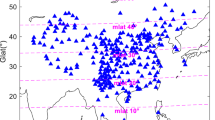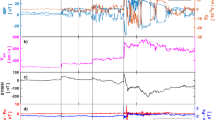Abstract
A series of studies have suggested proven that a geomagnetic storm can accelerate the formation of plasma depletions and the generation of ionospheric irregularities. Using observation data from the Continuously Operating Reference Stations (CORS) network in the USA, the responses of the ionospheric total electron content (TEC) to the geomagnetic storm on September 8, 2017 are studied in detail. A mid-latitude trough was discovered from 01:00 UT to 06:00 UT in the USA with a length exceeding 5000 km. Medium-scale travelling ionospheric disturbances (MSTID) with wavelengths of 600–700 km were generated accompanied by a drop and perturbation in the electron density. The intensity of the MSTID fluctuations reached over 2.5 TECU, which were discovered by filtering the differential TEC. SWARM spaceborne observations also showed a drop in the electron density from 105 to 103 compared to the background values at 28° N, 96° W, and 25° N, 95° W. This research investigates super-scale plasma depletions generated by geomagnetic storms using both CORS GNSS and spaceborne observations. The proposed work is valuable for better understanding the evolution of ionospheric depletions during geomagnetic storms.










Similar content being viewed by others
References
Aa E, Huang W, Liu S, Ridley A, Zou S, Shi L, Chen Y, Shen H, Yuan T, Li J, Wang T (2018) Midlatitude plasma bubbles over china and adjacent areas during a magnetic storm on 08 September 2017. Space Weather Int J Res Appl. https://doi.org/10.1002/2017SW001776
Aa E, Zou S, Ridley A, Zhang S, Coster AJ, Erickson PJ, Liu S, Ren J (2019) Merging of storm time midlatitude traveling ionospheric disturbances and equatorial plasma bubbles. Space Weather Int J Res Appl. https://doi.org/10.1029/2018SW002101
Aarons J (1991) The role of the ring current in the generation or inhibition of equatorial F, layer irregularities during magnetic storms. Radio Sci 26(4):1131–1149
Abdu MA, Batista IS, Takahashi H, Macdougall J, Sobral JH, Medeiros AF, Trivedi N (2003) Magnetosphere disturbance induced equatorial plasma bubble development and dynamics: a case study in Brazilian sector. J Geophys Res Space Phys. https://doi.org/10.1029/2002JA009721
Astafyeva E, Zakharenkova I, Förster M (2015) Ionospheric response to the 2015 St. Patrick’s day storm: a global multi-instrumental overview. J Geophys Res 120:9023–9037. https://doi.org/10.1002/2015ja02162
Astafyeva E, Zakharenkova I, Alken P (2016) Prompt penetration electric fields and the extreme topside ionospheric response to the June 22–23, 2015 geomagnetic storm as seen by the swarm constellation. Earth Planets Space 68(1):152
Basu S, Basu S, Rich FJ, Groves KM, Mackenzie E, Coker C, Sahai Y, Fagundes P, Becker-Guedes F (2007) Response of the equatorial ionosphere at dusk to penetration electric fields during intense magnetic storms. J Geophys Res Space Phys. https://doi.org/10.1029/2006JA012192
Blanc M, Richmond AD (1980) The ionospheric disturbance dynamo. J Geophys Res 85:1669–1686. https://doi.org/10.1029/JA085iA04p01669
Chen W, Gao S, Hu C, Chen Y, Ding X (2008) Effects of ionospheric disturbances on GPS observation in low latitude area. GPS Solut 12(1):33–41
Cherniak I, Zakharenkova I (2016) First observations of super plasma bubbles in Europe. Geophys Res Lett 43(21):11137–11145
Cherniak I, Zakharenkova I (2017) New advantages of the combined GPS and GLONASS observations for high-latitude ionospheric irregularities monitoring: case study of June 2015 geomagnetic storm. Earth Planets Space 69(1):66
Cherniak I, Zakharenkova I, Krankowski A (2014) Approaches for modeling ionosphere irregularities based on the TEC rate index. Earth Planets Space 66(1):165
Cherniak I, Krankowski A, Zakharenkova I (2018) Roti maps: a new IGS ionospheric product characterizing the ionospheric irregularities occurrence. GPS Solut 22(3):69
Ciraolo L, Azpilicueta F, Brunini C, Meza A, Radicella SM (2007) Calibration errors on experimental slant total electron content (TEC) determined with GPS. J Geod 81(2):111–120
Davis TN, Sugiura M (1966) Auroral electrojet activity index AE, and its universal time variations. J Geophys Res 71(3):785–801
Demyanov VV, Yasyukevich YV, Ishin AB, Astafyeva EI (2012) Ionospheric super-bubble effects on the GPS positioning relative to the orientation of signal path and geomagnetic field direction. GPS Solut 16(2):181–189
Fejer BG, Jensen JW, Kikuchi T, Abdu MA, Chau JL (2015) Equatorial ionospheric electric fields during the November 2004 magnetic storm. J Geophys Res Space Phys. https://doi.org/10.1029/2007JA012376
Forte B, Radicella SM, Ezquer RG (2002) A different approach to the analysis of GPS scintillation data. Ann Geophys 45(3–4):551–561
Hernández Pajares M, Juan JM, Sanz J (2006) Medium-scale traveling ionospheric disturbances affecting GPS measurements: spatial and temporal analysis. J Geophys Res Space Phys. https://doi.org/10.1029/2005JA011474
Huang CS, Foster JC, Sahai Y (2007) Significant depletions of the ionospheric plasma density at middle latitudes: a possible signature of equatorial spread F, bubbles near the plasmapause. J Geophys Res Space Phys. https://doi.org/10.1029/2007JA012307
Huba JD, Joyce G (2010) Global modeling of equatorial plasma bubbles. Geophys Res Lett 37(17):L17104
Jin S, Jin R, Kutoglu H (2017) Positive and negative ionospheric responses to the March 2015 geomagnetic storm from BDS observations. J Geod 91(6):613–626
Kakad B, Gurram P, Sundari T, Tripura Sundari PNB, Bhattacharyya A (2016) Structuring of intermediate scale equatorial spread F irregularities during intense geomagnetic storm of solar cycle 24. J Geophys Res 121:7001–7012. https://doi.org/10.1002/2016ja022635
Knudsen WC (1974) Magnetospheric convection and the high-latitude F2 ionosphere. J Geophys Res 79:1046–1055. https://doi.org/10.1029/ja079i007p01046
Komjathy A, Sparks L, Wilson BD, Mannucci AJ (2005) Automated daily processing of more than 1000 ground-based GPS receivers for studying intense ionospheric storms. Radio Sci 40(6):1–11
Kozyreva OV, Pilipenko VA, Zakharov VI, Engebretson MJ (2017) GPS-TEC response to the sub-storm onset during April 5, 2010, magnetic storm. GPS Solut 21(3):927–936
Li G, Ning B, Zhao B, Liu L, Wan W, Ding F, Xu J, Liu J, Yumoto K (2009) Characterizing the 10 November 2004 storm-time middle-latitude plasma bubble event in Southeast Asia using multi-instrument observations. J Geophys Res Space Phys. https://doi.org/10.1029/2009JA014057
Liu JY, Lin CH, Tsai HF, Liou YA (2004) Ionospheric solar flare effects monitored by the ground-based GPS receivers: theory and observation. J Geophys Res Space Phys. https://doi.org/10.1029/2003JA009931
Liu Y, Fu L, Wang J, Zhang C (2018) Studying ionosphere responses to a geomagnetic storm in June 2015 with multi-constellation observations. Remote Sens 10(5):666
Ma G, Maruyama T (2006) A super bubble detected by dense GPS network at east Asian longitudes. Geophys Res Lett 33(21):241–255
Mao T, Sun L, Hu L, Wang Y, Wang Z (2015) A case study of ionospheric storm effects in the chinese sector during the October 2013 geomagnetic storm. Adv Space Res 56(9):2030–2039
Meggs RW, Mitchell CN, Honary F (2008) Gps scintillation over the European arctic during the November 2004 storms. Gps Solutions 12(4):281–287
Mikhailov A, Schlegel K (1998) Physical mechanism of strong negative storm effects in the daytime ionospheric f2 region observed with eiscat. Annales Geophys 16(5):602–608
Nava B, Rodríguez Zuluaga J, Alazo Cuartas K, Kashcheyev A, MigoyaOrué Y, Radicella SM, Amory Mazaudier C, Fleury R (2016) Middle and low latitude ionosphere response to 2015 St. Patrick’s Day geomagnetic storm. J Geophys Res Space Phys 121:3421–3438
Nayak C, Tsai LC, Su SY, Galkin I, Tan A, Nofri E, Jamjareegulgarn P (2016) Peculiar features of the low- and mid-latitude ionospheric response to the St. Patrick day geomagnetic storm of March 17 2015. J Geophys Res 121:7941–7960. https://doi.org/10.1002/2016ja022489
Nayak C, Tsai LC, Su SY, Galkin I, Caton RG, Groves KM (2017) Suppression of ionospheric scintillation during St. Patrick’s Day geomagnetic super storm as observed over the anomaly crest region station Pingtung, Taiwan: a case study. Adv Space Res 60(2):396–405
Nishioka M, Saito A, Tsugawa T (2009) Super medium scale traveling ionospheric disturbance observed at mid latitude during the geomagnetic storm on 10 November 2004. J Geophys Res Space Phys. https://doi.org/10.1029/2008JA013581
Pi X, Mannucci AJ, Lindqwister UJ, Ho CM (1997) Monitoring of global ionospheric irregularities using the worldwide GPS network. Geophys Res Lett 24(18):2283–2286
Ram ST, Yokoyama T, Otsuka Y, Shiokawa K, Sripathi S, Veenadhari B, Heelis R, Ajith KK, Gowtam VS, Gurubaran S, Supnithi P, Huy ML (2015) Dusk-side enhancement of equatorial zonal electric field response to convection electric fields during the St. Patrick’s day storm on 17 March 2015. J Geophys Res. https://doi.org/10.1002/2015ja021932
Ray S, Roy B, Das A (2016) Occurrence of equatorial spread F during intense geomagnetic storms. Radio Sci 50(7):563–573
Singh R, Sripathi S, Sreekumar S, Banola S, Emperumal K, Tiwari P et al (2015) Low latitude ionosphere response to super geomagnetic storm of 17/18 March 2015: results from a chain of ground based observations over Indian sector. J Geophys Res Space Phys 120(12):10864–10882
Spiro RW, Wolf RA, Fejer BG (1988) Penetrating of high latitude electric field effects to low latitudes during sundial 1984. Ann Geophys 6:39–49
Tsugawa T, Otsuka Y, Coster AJ, Saito A (2007a) Medium-scale traveling ionospheric disturbances detected with dense and wide TEC maps over North America. Geophys Res Lett 34(22):48–55
Tsugawa T, Kotake N, Otsuka Y, Saito A (2007b) Medium-scale traveling ionospheric disturbances observed by GPS receiver network in Japan: a short review. GPS Solut 11(2):139–144
Wang W, Lei J, Burns AG, Solomon SC, Wiltberger M, Xu J, Zhang Y, Paxton L, Coster A (2010) Ionospheric response to the initial phase of geomagnetic storms: common features. J Geophys Res Space Phys. https://doi.org/10.1029/2009JA014461
Wei Y, Zhao B, Li G, Wan W (2015) Electric field penetration into earth’s ionosphere: a brief review for 2000–2013. Sci Bull 60(8):748–761
Wen D, Yuan Y, Ou J, Zhang K (2010) Ionospheric response to the geomagnetic storm on August 21, 2003 over china using GNSS-based tomographic technique. IEEE Trans Geosci Remote Sens 48(8):3212–3217
Yue X, Wang W, Lei J, Burns A, Schreiner WS (2016) Long lasting negative ionospheric storm effects in low and middle latitudes during the recovery phase of the 17 March 2013 geomagnetic storm. J Geophys Res Space Phys 121:9234–9249
Zhang S-R, Coster AJ, Erickson PJ, Goncharenko LP, Rideout W, Vierinen J (2019) Traveling ionospheric disturbances and ionospheric perturbations associated with solar flares in September 2017. J Geophys Res Space Phys. https://doi.org/10.1029/2019JA026585
Zhao B, Wan W, Liu L, Mao T (2007) Morphology in the total electron content under geomagnetic disturbed conditions: results from global ionosphere maps. Ann Geophys 25:1555–1568
Zhong J, Wang W, Yue X, Burns AG, Dou X, Lei J (2016) Long-duration depletion in the topside ionospheric total electron content during the recovery phase of the March 2015 strong storm. J Geophys Res Space Phys 121(5):4733–4747
Acknowledgments
This work was supported by the National Key Research and Development Plan by Ministry of Science and Technology 2016YFC1402502, the National Natural Science Foundation of China Innovation Group 61521091 and National Natural Science Foundation of China under Grant 61771030, 61301087. The contribution is also supported by the 2011 Collaborative Innovation Center of Geospatial Technology and Youth Excellence Talent Project of Beihang University. The authors would like to thank the reviewers for their detailed and insightful comments and constructive suggestions. Special thanks should be given to China Scholarship Council for the great supports of this research. Y.L. gives special thanks to Abdus Salam International Centre for Theoretical Physics during her stay at the Telecommunications/ICT for Development Laboratory of the Centre. Special thanks to all providers of data used (OMNIweb from NASA Goddard Space Flight Center to provide IMF Bz, solar wind data; International Services of Geomagnetic Indices to provide Dst, AE/AU/AL data, National Geodetic Survey to provide CORS GPS data, European Space Agency to provide SWARM data used in this research).
Author information
Authors and Affiliations
Corresponding author
Additional information
Publisher's Note
Springer Nature remains neutral with regard to jurisdictional claims in published maps and institutional affiliations.
Rights and permissions
About this article
Cite this article
Liu, Y., Li, Z., Fu, L. et al. Studying the ionospheric responses induced by a geomagnetic storm in September 2017 with multiple observations in America. GPS Solut 24, 3 (2020). https://doi.org/10.1007/s10291-019-0916-1
Received:
Accepted:
Published:
DOI: https://doi.org/10.1007/s10291-019-0916-1




